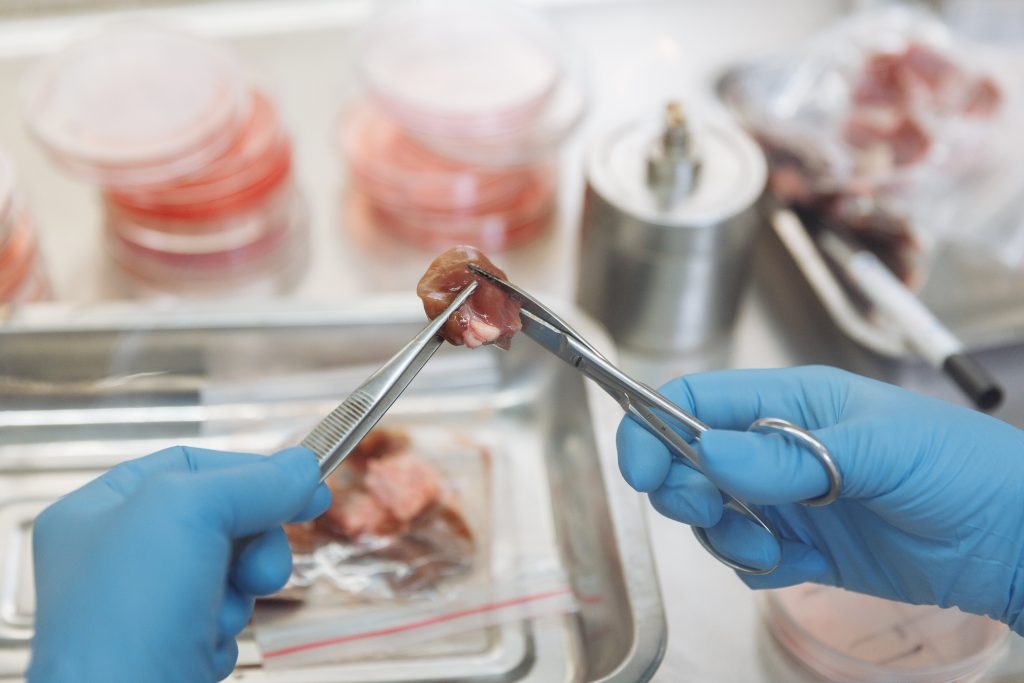Allergen management
Allergens have to be managed. All our allergens can be determined through the SpecCheck. This applies to all raw materials, excipients, and end products. But also for the products used for product development. Cross-contamination of allergens or unintended presence of allergens (not declared on the label) can be caused by, for example:
- Presence in raw material, while this is not mentioned in the raw material specification.
- Use of the wrong recipe or incorrect execution of the recipe.
- Incorrect labelling or use of the wrong label or packaging.
- Inadequate cleaning.
- Wrong planning sequence.
- Cross-contamination by employees (hands, clothing, footwear).
- Broken or open the packaging.
- Accumulation via aids, equipment, machines, internal means of transport, crates, buckets, shovels, measuring instruments, etc.
- Accumulation through the air (including the ventilation system) or water.
- Accumulation via tools of maintenance technician.
Risk analysis
With the risk analysis about cross-contamination or carry-over of allergens, the account is taken of:
• the physical state of the allergens (for example, in powder form, sticky substance, or particle size).
• potential places in the process where cross-contamination can occur.
The physical state of the allergens within our company is, among other things, in powder form (excipients and raw materials) and processed in products. Therefore, the most excellent chance of cross-contamination lies with the weighing and processing of these additives. We have checked with our suppliers whether possible cross-contamination is mentioned on the specifications and label. In addition to the specifications, the supplier may request additional information via questionnaires. This can provide information about allergens in the raw materials, ingredients, and possible cross-contamination in the plant or process.
Possible control measures include
1. physical separation; storage location, identification, a specific department, or line.
2. separation in time (planning). The production takes place in as large batches as possible, and the production sequence depends on the allergens (least amount of allergens first).
3. hygiene rules, dedicated clothing, materials, and equipment. Replacement of clothing before/after production or fouling.
4. cleaning and disinfection, checking using swabs, testing. The method is dependent on risk analysis (potential contamination above limit values).
5. positive release.
6. visual inspection.
7. waste management.
8. permitted foods in the canteen.
9. rework management.
Allergen management is part of the internal audit and verification.
New allergens
All new raw materials and additives may not contain “new” allergens. New allergens must first be assessed to whether they can be integrated into our production process and current measures. This assessment is permanently recorded in a validation.
Product development
Product development involves validating which allergens are present, what control measures should be taken and how these products fit into the planning sequence.
Reception
Products are only received in sealed packages. When packages are open or torn, it must first be assessed whether contamination could have occurred. In the event of possible allergen contamination, the batch must be refused.
Storage
Allergens are taken into account during storage. The products with the most allergens are listed at the bottom of the racks. Products without allergens are placed at the top of the rack. Open packages are never placed in storage. This is to prevent possible cross-contamination. All packages are also cleaned before they are placed in storage.
If it appears that products have been placed incorrectly or dirty packaging is in storage, an estimation of the possible cross-contamination must occur. In the event of possible cross-contamination, these products will be destroyed. Or if the recipe (allergens) allows this to be processed after cleaning the packaging.
Weighing additives
The additives are mainly powders. This increases the risk of cross-contamination in the air. The packages are carefully opened (for example, cut open rather than torn). The weighing of the allergenic raw materials or additives is done separately. After weighing each raw material, the packaging is closed before opening the following raw material or additive. The scale is cleaned, or the bowl or bucket is weighed. This applies to all the materials used. After cleaning, the next additive is weighed. Basic seasoning occurs in production, where the highest chance of cross-contamination with allergens is possible.
Production
Possible control measures include:
1. physical separation; location, identification, a specific department, or line.
2. separation in time (planning). The production takes place in as large batches as possible, and the production sequence depends on the allergens (most minor allergens first).
3. hygiene rules, dedicated clothing, materials, and equipment. Replacement of clothing before/after production or fouling.
4. cleaning and disinfection, checking using swabs, testing. The method is dependent on risk analysis (potential contamination above limit values).
5. positive release.
6. visual inspection.
7. waste management.
8. rework management.
The most significant risk arises when adding additives to our products. After the addition, what has been spilt is immediately cleaned. Therefore, the cleaning methods must be validated for effectiveness, and the cleaning procedure must be checked frequently. For this purpose, cleaning material specially used for cross-contamination elimination must be recognisable (e.g. differ-colours lour).
After putting together the products, the chance of cross-contamination is considerably smaller. Before starting a new product:
• Any product residues are cleaned up.
• The machines and tables are cleaned of smearing. Some machines cannot be cleaned. With these machines, the first product (part) is destroyed.
• The material is cleaned.
Cleaning
The cleaning activities must be organised so that the chance of possible cross-contamination by allergens is eliminated or reduced to acceptable levels.
Labelling
When starting the line, product changes and changes in the packaging material must be carefully considered to ensure the correct label is on the right product.
Staff
Our staff are not allowed to eat in company clothing. This is to prevent cross-contamination with allergens from one’s food. Every employee must adhere to this.
Claims
In the event of claims, the production process must be fully validated, including the raw material suppliers. And the effectiveness of the production process with which this claim is made must be frequently verified. If the risk analysis shows that cross-contamination with an allergen cannot be prevented, a warning is placed on the packaging that the product may contain this allergen. In the risk analysis, a tool can calculate the potential contamination (worst case) and assess whether it is below or above the limit.
Related articles to Allergen management within a food company
Many customers and visitors to this page 'Allergen management within a food company' also viewed the articles and manuals listed below:



